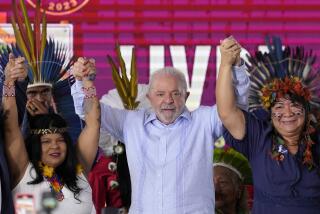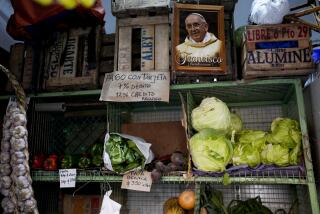Debt Slows Latin Growth, UN Says : Continent Owes $410 Billion, Fueling 187% Inflation Rate
- Share via
SANTIAGO, Chile — Struggling with average annual inflation of 187% and a combined foreign debt of $410 billion, the economies of Latin America lost momentum in 1987, according to a report issued Tuesday by the United Nations Economic Commission for Latin America and the Caribbean.
“In 1987, the economic crisis that Latin America has been suffering since the beginning of the present decade was aggravated,” the report said. “The deterioration of internal social conditions increases the challenges faced by the processes of building democracy in the region.”
The Santiago-based commission, which uses the acronym ECLA, said in its preliminary annual report that Latin American inflation nearly tripled, jumping to 187% from 65% in 1986. Estimated annual economic growth for the region declined to 2.6% from 3.7% in 1986.
Flexibility Urged
The report emphasized the role of foreign debt in the region’s economic troubles. It said the heavy burden of debt service saps the capacity of Latin American countries to import capital goods needed for economic expansion, and that it severely limits the ability of governments to invest in development projects.
Big debt obligations also increase fiscal deficits, which are a major cause of inflation, the report said.
Norberto Gonzalez, ECLA executive secretary, said in an interview that creditor banks need to understand that a more flexible approach to the Latin American debt problem is in their own long-term interests. He said mechanisms must be found to reduce debt principals and interest rates so that Latin American countries can meet payments and develop economically at the same time.
He said a long-term solution will require the cooperation of international financial institutions, private banks and governments of both the debtor countries and the industrialized nations.
“If they don’t come to an agreement, and each one pulls in its own direction, we are going to continue in this impasse, which has lasted six years, with increasing deterioration,” said Gonzalez, an Argentine economist.
According to the ECLA report, the combined foreign debts of Latin American and Caribbean countries grew to $409.8 billion in 1987 from $392.9 billion in 1986. The largest debts are Brazil’s $116.9 billion, Mexico’s $105.6 billion and Argentina’s $54.5 billion.
Servicing the debt costs Latin America every year much more than it receives. From 1982 through 1987, despite the failures of some countries to keep up with debt payments, the region’s net transfers of money abroad totaled $145 billion, ECLA calculated.
Inflation, one of the most painful symptoms of Latin America’s economic illness, surged in 1987 after a lull the previous year. The average 1986 rate for the region was 65%--down from 275% in 1985 and the lowest rate in four years--but, by late 1987, the annual rate was back up to 187%.
The regional increase was spurred by galloping inflation in Brazil, the largest country, where price control programs have collapsed in failure. Brazilian prices rose by 338% in the 12 months through November, up from 58% in calendar 1986.
The highest inflation for 1987 was in Nicaragua, with a rate of 1,226% during the 12 months ending in November. Argentina had 178%, Mexico 144% and Peru 105%.
Bolivia’s rate was 10%, the product of an austerity program that has reduced inflation from a roaring 8,170% in 1985 to 66% in 1986.
The 2.6% economic growth rate for Latin America in 1987 was the lowest since 1983, when recession resulted in a shrinkage of 2.6%. ECLA said the decline in 1987 growth reflected a drop in Brazil’s expansion to about 3% from more than 8% in 1986.
Ecuador’s economy contracted by 3% in 1987 mainly as a result of damaging earthquakes in March. The fastest growth rates in the region were 7% for Peru and the Dominican Republic, and 5.5% for Colombia, Chile and Uruguay.
0.5% Growth Per Capita
Mexico grew by an estimated 1% and Argentina by 2%.
ECLA observed that if regional population growth is taken into account, economic growth was a meager 0.5% for each Latin American.
“Thus, for the sixth consecutive years, the weak evolution of economic activity in most of the region’s countries was clearly insufficient to avoid economic deterioration and a worsening of living conditions” for the region’s 416 million people, Gonzalez told a news conference Tuesday.
One of the few encouraging trends in the ECLA report was an increase in Latin America’s trade surplus to $23 billion from $18 billion in 1986.
More to Read
Sign up for Essential California
The most important California stories and recommendations in your inbox every morning.
You may occasionally receive promotional content from the Los Angeles Times.










